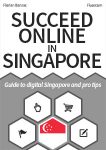With the 2015 budget of Singapore came an increase of the personal income tax rate to 22% for the highest income. In this interview, Singapore Second Minister for Trade and Industry S. Iswaran gives some insights on the objectives of the Singaporean government’s fiscal policy and strategy for investment, redistribution and funding.
In this interview by Bloomberg’s Haslinda Amin, Singapore Second Minister for Trade and Industry S. Iswaran provides some insights on the government’s approach to income and corporate tax, public investments, redistribution and orientations of public policies in Singapore.
Key orientations of Singapore’s policies for work and economy
Personal income tax
The highest tax rate for personal income is 22% for the top 5% earners. With this rate Singapore remains in the countries with the lowest income tax among developed countries. Yet, this rise of 2% from the previous 20% makes personal income tax higher than in Hong Kong and its 17% flat rate income tax.
Yet, as S. Iswaran points out, the competition for skilled workers is global and Singapore should be compared to all developed countries, against most of which it remains very competitive. Furthermore, Singapore is also very competitive in terms of value provided to businesses, with its location in Asia, a low corporate tax rate of 17% and low other indirect taxes.
The economy and quality of life of Singapore also influences business and workers’ choices for coming and staying in Singapore, especially if they have families. The high cost of living in Singapore enables the city-state to be selective by attracting only the highest value added businesses which will ultimately make Singapore more competitive by creating higher income jobs.
Taxes and public funding
The Singaporean government is engaged in finding new sources of funding for its activities, by broadening the tax base: it increased the personal income tax and taps some of the countries’ state-owned wealth funds such as GIC, Temasek and MAS.
It is carefully imposing new taxes on these funds by evaluating the net investment returns so as not to over-tax them and allow for further levy later. The government is also studying other opportunities such as tapping into capital markets or the bond market, but it will not modify the corporate tax rate for the remainder of this decade.
Redistribution
By increasing its levy on the highest revenues, the Singaporean government’s goal is to spare the middle income group and enhance redistribution. It wants to create transfers through education, healthcare or housing to the lower income group, particularly affected by the high costs of living in Singapore.
With its expenditures, the most important aspect is that the Singaporean government wants to invest for the long-run, with large, important and long-term projects, such as the extension of the Changi airport or public transportation which will help the Singaporean economy and provide benefits for the larger population.
The increase in inequalities is a global challenge with top talents’ incomes rising while middle and lower incomes stagnate; it is exacerbated in cities such as Singapore. Singapore’s fiscal policy should reduce these inequalities, but it’s really investments for skills enhancement that will allow more people to take higher skilled jobs, increase their incomes, improve their lifestyles and quality of life.
Foreign workers
Even though Singapore is open for business, the number of foreign workers allowed in Singapore has been curbed. The logic behind this is that the small size of Singapore naturally limit the number of people that its economy can absorb. Even though limits have been set, the number of foreign workers is still growing.
The goal for Singapore is not to attract low-cost workers but highly skilled talent for industries with high productivity to increase the country’s competitiveness. On par to this, the focus is to enable the local population to take a more important participation in these highly productive businesses.
Nevertheless, the lack of labor in Singapore causes problems, it has forced certain companies to withdraw from Singapore. It’s the task of every business to assess its interests in being present in Singapore for their Asia-Pacific activities. Singapore obtains a lot of foreign investments, the governments wants to make sure they are high value-added investments which will provide benefits to the country for the long-run.
Economic strategy
Through all these policies, the goal of the Singaporean government’s economic strategy is clear in the words of S. Iswaran :
“…emphasis on quality growth, on high value added sectors, on the use of technology and enhancing the skills base of our people. This is continuing to be the key platform for our economic strategy.”
“It has to be high value added, it has to be focused on the larger Asia-Pacific market, and Singapore becomes a node in that larger network.”
Bloomberg video from February 2015



![Guide to taxes in Cambodia [brackets-incentives] Taxes in Cambodia](https://aseanup.com/wp-content/uploads/2016/03/Cambodia-taxes-150x68.jpg)





